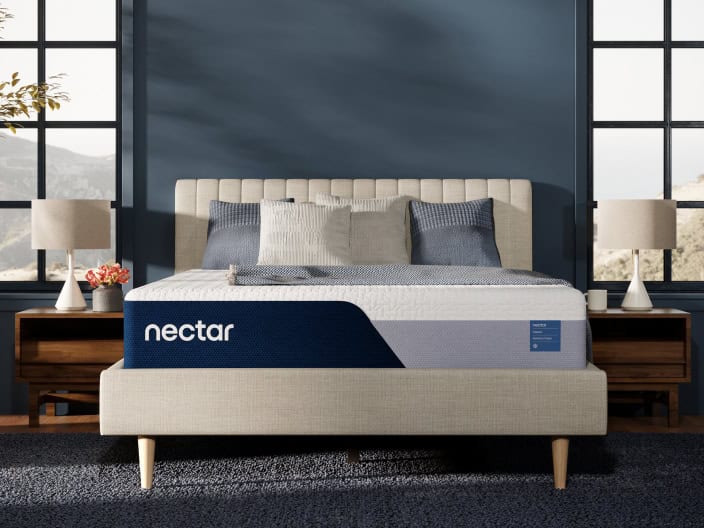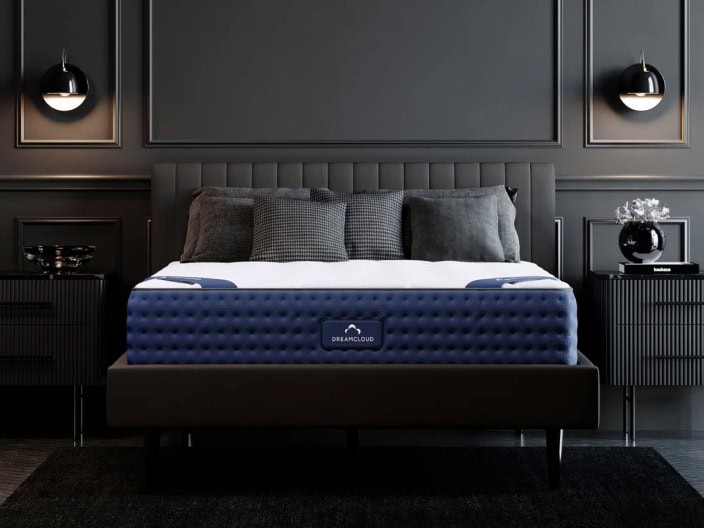7 Different Types of Blankets
Share
Fact checked
Reviewed by experts
Updated
December 27, 2022
Quick read
6 mins to read
List of Content
Nothing beats the feeling of sleeping in a warm, cozy blanket and getting good sleep. Each blanket has its advantages and disadvantages, whether a traditional comforter or an electric blanket. However, buying a new blanket can be challenging with the number of options available in the market. Our detailed article will help you understand seven different types of blankets with their pros and cons.
Different Types of Blankets
Let us understand the different types of blankets in this section, with their advantages and disadvantages.
1. Comforter
Comforter is perhaps one of the most popular types of blankets in the market. It is made from two fabrics stitched together and filled with a warm material. The materials used are polyfill, down, feathers, latex, or cotton. The outer surface of the blanket is mixed with cotton or polyester for additional softness.
Comforters are known for their heat retention properties and are suitable for sleepers who love to sleep warm. Also, comforters are very light in weight. The cloud-like and fluffy patterns you see in the hotels are due to these soft and smooth comforters.
Pros:
- Comforters are light in weight
- Excellent heat resistant properties
- A good option for warm sleepers
- You can use it with a duvet cover to improve the look of your bedroom
Cons:
- Some comforters may require regular maintenance
- It may be uncomfortable for sleepers in a hot climate
2. Duvet
There is very little difference between duvets and comforters. Duvets are used with duvet covers. These covers are fabric covers that drape the duvet comfortably. When placed on the mattress, a duvet looks like a white comforter. Duvet has laces on the corners to bind it to the duvet cover. The fillings inside a duvet usually consist of down, polyester, or cotton.
Pros:
- You can use it without a top sheet
- You can change the looks of the bedroom by changing a duvet cover
Cons:
- It is expensive than a comforter
- It May get lumpy at times
- Changing covers can be tough
3. Quilt
Quilts have been used as blankets from ancient times. The quilt consists of three layers: a top, bottom, and middle layer of insulating material. The top layer is made from multiple fabrics stitched together. The middle layer is filled using cotton, down, or wool. The bottom layer is made from a single piece of cloth.
The quilt’s weight is less than other blanket types like comforters. They are an excellent option for sleepers who love to sleep in a warm climate. Quilts offer a smooth and sleek look to your bed.
Pros:
- It gives a structured look to your bed
- It keeps you cooler than a comforter or a duvet
- Takes less space
Cons:
- Slightly heavier
- More expensive as more materials are used
- Some quilts may restrict your movement
4. Throw Blanket
Throws are primarily used for decoration. You can use a throw blanket on a bed or a sofa to improve the aesthetics. The size of these blankets is very small. Throws are made from a single layer of fabric.
Throw blankets have a multi-season use; you can use a throw on a comforter during winters; meanwhile, you can also cover your feet during reading or relaxing during summers. Throws are weaved, woven from an insulating material or wool in some cases.
Pros:
- Improves the look of your bedroom
- You can use it as decor or cover depending on the season
Cons:
- It cannot be used as a primary blanket
- Difficult to wash
5. Coverlet
Coverlet is a thin layered blanket made from light materials such as cotton or silk. You can use a coverlet between the sheet and a duvet cover to provide extra comfort. Coverlet can also be used as decor to improve the aesthetics of your sleeping space.
Pros:
- Extremely lightweight and thin
- Easy to wash and maintain
- Less expensive than throw
Cons:
- It cannot be used as a primary blanket
- Not as warm as other blankets
6. Weighted Blanket
A weighted blanket gives you the perfect feel of a blanket, thanks to the extra cushion it provides to your body while sleeping. Weighted blankets are filled using plastic pellets which makes them unique. These plastic pellet fillings add up a considerable weight of around 20 pounds that helps it wrap comfortably around your body and gives the desired warm feeling.
It helps in reducing the heart rate before sleeping that enables you to fall asleep quicker. According to a study from Penn medicine, pressure therapies like these also help in reducing symptoms of depression, stress, anxiety, ADHD, and autism.
Pros:
- Improves sleep considerably
- It induces calmness and relaxes your mind
- Reduces stress, anxiety, and depression
Cons:
- Challenging to move because of their weight
- Expensive than other blankets
- It can be uncomfortable for hot sleepers
- It may not be easy to wash because of their weight
7. Electric Blanket
Electric blankets are the new trend in the blanket market. It is made from a heavy material, and the underlying layers consist of a wiring system with coils that produce heat. The material used is polyester and acrylic to avoid any burns in the blanket. It also consists of remote control to maintain the level of heat within the blanket.
Pros:
- Extra heat reduces minor aches and pain in the body
- Creates a warm and cozy bed
Cons:
- Risk of fire due to internal wiring
- May lead to miscarriage in pregnant women
- May overheat in summers.
Different Types of Blanket Materials
Depending on the blanket material types, there are various types of blankets. Below are the most common types of blankets.
1. Cotton Blankets
Cotton blankets are made from a single piece of cotton. They are knitted in a thin layer. Cotton blankets are hypoallergenic and highly breathable. They are the best blanket material for sleepers with sensitive skin, such as toddlers, young children, and pregnant women. You can use them in summers as a thin blanket and an extra cover with blankets in winter.
Pros:
- Highly breathable
- Hypoallergenic
- Suitable for people with sensitive skin
- Odorless
Cons:
- Not warm in winters
- Highly flammable
- May shrink after a while
2. Down Blankets
Down fillings are used in a variety of comforters, blankets, or duvets. Down blankets are made from quill-free feathers from the skin of birds and ducks. Down feathers are lightweight with good heat-resistant properties.
The most common use of down is in comforters. It is also used in thinner blankets.
Pros:
- Not very expensive like other blankets
- Very easy to clean
- Easy to move
Cons:
- Not comfortable for people with bird allergies
- Not very warm
3. Wool Blankets
Wool blankets have been in use since ancient times and are the warmest blanket material available. They trap air with their pockets within the fiber and help in providing a warm and cozy sleep. It is one of the best blanket fabrics and acts as a perfect insulator to keep the cold air out and hot air within the blanket. Wool blankets are knit with fringe edges.
Pros:
- Woolen blankets are solid and elastic
- Fire resistant
- Suitable for sleepers who wart warm while sleeping
- Reduces the humidity while sleeping
Cons:
- The quality of wool blankets varies considerably
- It can get too warm in summers
- It is not suitable for people with animal allergies
4. Fleece Blankets
A fleece blanket is one of the easiest blankets to find in the markets. Fleece is a cloth made from polyester, and fleece blankets are a single layer of this fabric. Fleece blankets are smooth and warm. You can use fleece blankets below the bed cover.
Pros:
- Fleece blankets are lightweight
- High durability
- High breathability
- Moisture resistant
Cons:
- Cannot wash at high temperatures
- Dirt and dust mites may attract to fleece blankets
5. Microfiber Blankets
If you want to regulate heat in your body, then bamboo blankets or heated blankets are your best bet. Bamboo acts as an excellent insulator; it absorbs sweat and traps the warm air from your body. It keeps you dry and insulated.
Pros:
- It is also antimicrobial and antibacterial
- It is odorless
- Excellent heat resistant properties
- Good for hot sleepers
Cons:
- You cannot wash it using the washing machine
- It may not be comfortable for some sleepers in summers
6. Acrylic Blankets
Acrylic is an artificial polymer extracted from petroleum or fossil fuels. It is a lightweight material and provides sound insulation. Acrylic blankets have a wool-like texture and feel and have high durability.
They have less breathability. You can wash and dry acrylic blankets hundreds of times without any damage.
Pros:
- Acrylic blankets are lightweight
- Helps you to stay warm
Cons:
- You cannot wash acrylic blankets at a high temperature
- Not environment friendly
- May lead to chronic diseases such as cancer
7. Polyester Blankets
Polyester blankets are made from synthetic polyester fibers that feel soft and smooth against the skin. It is not as smooth as cotton but much affordable compared to cotton or other natural blankets. Polyester blankets are long-lasting and do not lose shape, size, and color for years.
Combination blankets with a blend of organic cotton and polyester are also available in the market. These blankets provide the firmness and longevity of polyester alongside the smooth feel of cotton.
Pros:
- High durability
- Great at resisting heat
- Do not wrinkle easily
- Water-resistant
- Most affordable blanket
Cons:
- Can cause skin allergies
- Not environment friendly
8. Bamboo Blankets
If you want to regulate your body temperature, then bamboo blankets are your best bet. Bamboo acts as an excellent insulator; it absorbs sweat and traps the warm air from your body. It keeps you dry and insulated.
Pros:
- It is also antimicrobial and antibacterial
- It is odorless
- excellent heat resistant properties
- Good for hot sleepers
Cons:
- You cannot wash it using the washing machine
- It may not be comfortable for some sleepers in summers
The Final Word
After going through so many types of blankets, you might be getting a question on which blanket type is the best for you. Well, the answer to this question is within your choice of fabric for blankets, blanket styles, sleeping habits, and preferences. You need to decide whether a heavy duvet, a soothing weighted blanket, or a smooth cotton blanket suits you the best.
Probably, you can try a few blankets before deciding which blanket matches perfectly with your sleeping requirements. Hopefully, our guide will help you in making the right choice.
Happy Sleeping!
FAQs
The blankets with properties such as strength, softness, and warmth are the most comfortable blankets to sleep with. However, the best blanket differs from person to person and depends on your sleep requirements.
Throw blankets are primarily used for decoration. You can also use a throw on a comforter during winters and cover the feet while reading or relaxing during summers.
Cotton blankets, wool blankets, microbead blankets, electric blankets, and fleece blankets are the best blankets for the winter season.
Cashmere blankets with properties such as firmness, softness, and warmness are the most comfortable blankets to sleep with.
This website does not offer medical advice nor professional medical services; rather, it is provided solely for educational, informational, and/or entertainment purposes. Individuals seeking medical advice should consult a licensed physician. The information provided should not be used for diagnosis or treatment of any condition, disease, or injury. When you have a medical condition, you should always talk to licensed doctor or other certified medical professional. You should never delay seeking professional medical advice or treatment based on the contents of this website. Call 911 or immediately go to the nearest emergency room if you think you may have a medical emergency. The contents of this website are provided “as-is”, Sleep Authority and its parent, subsidiaries, affiliates, employees, contributors disclaim any warranty of the information contained herein. Please contact using contact form to report any errors, omissions, misinformation, or abuse.
Sleep Authority is brought to you by Resident, the company that brings you Nectar, DreamCloud, Awara, Wovenly, Bundle, Home Well Designed and Level Sleep.






